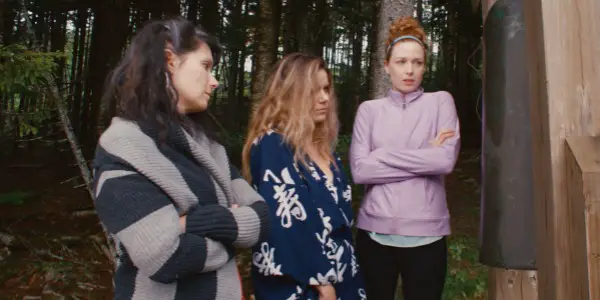AULD LANG SYNE: A Memorable Release Of Built-Up Tension

Amanda Mazzillo is a writer with an MFA in Dramatic…
Auld Lang Syne follows a New Year’s dinner between friends, who have been celebrating the holiday together for ten years. Vanessa (Kimberly Dilts) and Steven (J.T. Arbogast) host the dinner at the family’s cabin. The film delves into three relationships and their issues, without forgetting each character also has their own individual problems they must confront.
Early on, we learn Vanessa is awaiting news about a script she gave to her actress friend Sadie (Lucy Walters), while Steven is working on a campaign to raise money for his theater. The film looks at the relationships between three couples, who are greeted with brief introductions involving hints at their individual problems, before joining in the atmosphere of hiding everything until it needs to come out.
Sadie is first shown in the car with her boyfriend Jude (Caleb Bark) giving us a sense of their relationship and difference from the stress we see in Vanessa and Steven’s first appearance. We are also introduced to Jodie (Elisabeth Hower) and Bryce (Blake DeLong), who automatically make it known something is off-kilter this year.
As the dinner party progresses, Jodie and Bryce give a new year’s toast, in the form of a play, where everyone of their friends as a line to read. This delivery creates an interesting dissonance surrounding the news they are sharing. They are no longer a couple. This moment is the catalyst to the rest of the evening. This releases everyone from their tightly held secrets, sending them off towards cathartic screaming in the woods, flinging handfuls of pie across the room, and expressing their true thoughts and desires.
Setting Creating Tension
Auld Lang Syne utilized its small set to create tension between the characters. The director (Johanna McKeon) comes from a stage background, which comes across in how well she uses available space to build divides between the characters.
Auld Lang Syne cuts between scenes of the men and women hanging out, which visually shows the disconnection between the group of friends. Using a small space lets the filmmakers explore creative storytelling they might not have in a different setting. Being close to the characters, the audience gets a sense of immersion into the chaos and drama.

One of the most powerful scenes was of Vanessa and Steven running out of the house, carrying their drama into the yard, where the atmosphere felt removed from what went on inside, yet you could still see the house, with everyone else dealing with their own problems right through the door.
In one scene, Sadie and Jodie seclude themselves in a bathroom, away from everything else, yet still close enough to never feel as if they are not still in that moment, with their friends arguing. This scene creates tension between Sadie and Jodie, as well as creates a divide between them and the rest of their friends. The proximity of characters while in the bathroom adds to the emotion of the scene. If this was filmed in a larger space, the scene would not feel nearly as emotional and poignant.
Conversations Building Character
The conversations in Auld Lang Syne felt extremely natural, like we are sitting around with this group of friends, hearing them talk about anything that comes to mind. At times, the focus goes in and out, which actually adds to the experience of a group of friends getting drunk and letting their problems come out throughout the night. As it gets later and closer to the new year, everyone lets go of their secrets and releases their built-up tension through screaming, throwing things, and making out.
Auld Lang Syne could easily have devolved into men versus women or couple versus couple, but by developing each character through their actions and conversations, the audience gets to understand how each character has their own problems, outside of their relationships.

Sadie’s insecurities about her acting impact all of her relationships, not just her relationship with her boyfriend, Jude. Vanessa’s worries are not all rooted in her marriage to Steven. Bryce’s feelings about wanting children, which Jodie does not share, are as much a part of his worry of fitting in the corporate world into which he followed his father than they are about his relationship with Jodie.
Conclusion
At times, the film felt too focused on trivial problems, but the problems somehow felt real for the characters. I might have not been completely invested in weather or not the relationships would last the night, but I never felt they did not reflect the truth of the characters. This was a pleasant enough independent film, with a memorable ending, strong performances, and excellent use of space. I would recommend giving this a chance.
Auld Lang Syne is a nice addition to the small collection of films written, directed, and shot by women. Kimberly Dilts, Johanna McKeon, and Kimberly Culotta crafted a beautiful film utilizing nature, tension, and pie.
What did you think of Auld Lang Syne? Would you watch more films crafted by these women?
Auld Lang Syne is now streaming on Seed & Spark and Indie Street!
Does content like this matter to you?
Become a Member and support film journalism. Unlock access to all of Film Inquiry`s great articles. Join a community of like-minded readers who are passionate about cinema - get access to our private members Network, give back to independent filmmakers, and more.
Amanda Mazzillo is a writer with an MFA in Dramatic Writing from SCAD and a BA in Writing & Linguistics and Film Studies minor from Georgia Southern University. She enjoys writing comedy and exploring all forms of media. Her Twitter name is a bad pun: @mazzillofirefox













